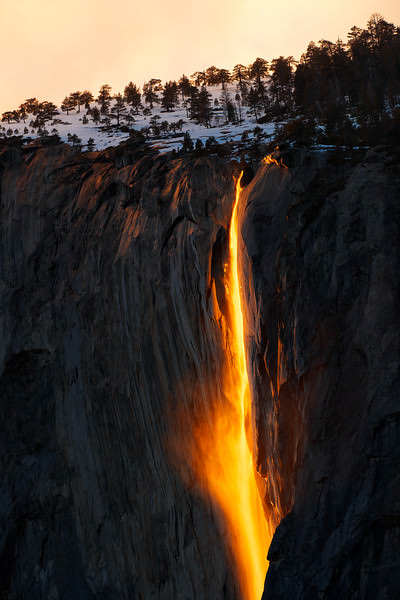A History of the Yosemite Firefall and Tips for Photographing It
![]()
Each year from summer of 1872, the owners of Glacier Point hotel started the event of Yosemite Firefall. For seven nights a week, they would spill hot embers from Glacier Point down to the valley 3000 feet below. The event ended in 1968 when the National Park Service ordered it to stop because the overwhelming number of visitors that it attracted overwhelmed the meadows, and because it was not a natural event. NPS wanted to preserve the Valley, returning it to its natural state.
“I broke the speed limit racing the light to the base, where I jumped a signed fence with my 300mm lens to get a clear view,” Galen writes in his book The Art of Adventure Photography. “Instead of writing one of the longer citations of his career, the ranger looked at the fantastic light and asked Is there anything else you need over there? My tripod. It’s on the back seat. The ranger passed it over and I gave him one of the first prints of a rare natural event that I discovered by accident.”
Since then, many photographers go to Yosemite to witness this event in the last two weeks of February. But this amazing display doesn’t always happen, there must be good water flow (snowpack) and clear skies to the west so the sun rays backlight the waterfall. This lighting condition also happens in late October, but usually there’s not enough water by this time.

There are two good spots to shoot from. The first one is the El Capitan picnic area on the Northside drive. This is where Galen took his famous shot. The second one is after Cathedral Beach picnic area on the Southside drive, there’s a turnout where the river bends closer to the road. This Google Map shows both locations.
![]()
Either spot you decide to shoot from, try to get there early. February sunset is around 5:30 PM. You probably need to be there by 2 PM or so to secure your spot. There will be hundreds of photographers in a very small area, so expect to have tripod’s leg to leg. El Capitan picnic area is more suitable if you are going with your family and kids as it has restrooms. All in all, bring a chair and a book or something to entertain yourself. Afternoon light can make very good high contrast shots, so snap a shot every half hour or so.
![]()
![]()
As the sun approaches its set, there will be what may look like a heart shape on El Capitan and the Horsetail falls, the shape will keep shrinking till the setting sun rays hit the wall behind the falls and backlight it.
![]()
![]()
The shape will keep shrinking and that’s when the falls will illuminate in a beautiful orange glow that turns into pink as the sun sets.
Be patient, as clouds may block the sun for a few moments and it may look that the falls won’t glow. Make sure to have a long lens with you. I had the 100-400mm with a 1.4x teleconverter on my camera — this helps you to get close and intimate with this stunning view.
![]()
![]()
After a glorious show, the falls may turn into a pink glow before it loses its color completely.
![]()
![]()
About the author: Akram Mellice is a photographer based in California. The opinions expressed in this article are solely those of the author. You can find more of Mellice’s work on his website, 500px, Flickr, and Instagram. This article was also published here.